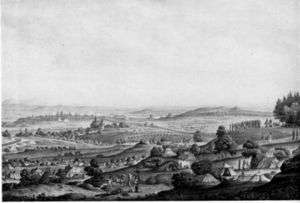Georg Melchior Kraus
Georg Melchior Kraus (26 July 1737, in Frankfurt am Main – 5 November 1806, in Weimar) was a German painter. A student of Johann Heinrich Tischbein, he was also a teacher himself (his pupils included Ferdinand Jagemann), as well as an entrepreneur and friend of Goethe. He was a co-founder of the Fürstliche freie Zeichenschule Weimar with Friedrich Justin Bertuch in 1776.
Life
Georg Melchior Kraus was the sixth of nine children, though five of these died before reaching a year. His parents Cornelia Kraus (née Paulsen) and Johann Georg Kraus ran the "Zur weissen Schlangen" hotel in the Sandgasse in Frankfurt. Georg Melchior Kraus was eight when his father remarried after Cornelia's early death.
From 1759 to 1762 he trained in the studio of the court painter Johann Heinrich Tischbein the Elder at the court of landgraf Frederick II of Hesse-Kassel. In November 1762 Georg Melchior travelled to Paris to study under the best-known copper-engraver of the time, Johann Georg Wille. In Paris he also came into contact with the genre painter Jean-Baptiste Greuze and soon became "genre painter familiar to His Holiness the prince bishop of Wirsbourg"
At the end of 1766 Kraus returned to Frankfurt, at first becoming a private tutor and genre painter. He maintained his French contacts so well that in 1776 he was included on Colisée's list as a genre painter. In Frankfurt his pupils included Sophie von La Roche, Friedrich Heinrich Jacobi and Johann Wolfgang von Goethe, while he also unsuccessfully petitioned the city council on 2 April 1767 for the establishment of a painting academy.
Gallery
 Die Klause bei Goslar (Klusfelsen)
Die Klause bei Goslar (Klusfelsen) The Pulverturm and the Johannistor in Jena
The Pulverturm and the Johannistor in Jena
Literary work
- Georg Melchior Kraus: ABC des Zeichners, von G. M. Kraus, Herzogl. S. W. Rath und Director der herzogl. Freien Zeichenschule in Weimar, 5. Aufl. Weimar 1810.
Bibliography
| Wikimedia Commons has media related to Georg Melchior Kraus. |
- Birgit Knorr: Georg Melchior Kraus (1737 - 1806) : Maler - Pädagoge - Unternehmer ; Biographie und Werkverzeichnis (Dissertation), Download als PDF
- Hans Wahl, Anton Kippenberg: Goethe und seine Welt, Insel-Verlag, Leipzig 1932 S.45, 56, 58f, 79f, 87, 95, 131, 139
- Gisold Lammel: Georg Melchior Kraus – Bildchronist im Weimar der Aufklärung und Klassik, in: Ders., Tagträume. Bilder im Lichte der Aufklärung, Amsterdam 1993, S. 185 193.
- Christine u. Markus Meissner: In der Freiheit der Berge - Auf Goethes Spuren im Harz, Weimar 1989.
- Eberhard Freiherr Schenk zu Schweinsberg: Verzeichnis der Radierungen von Georg Melchior Kraus, in: Jahrbuch der Sammlung Kippenberg, Bd. 7, (1927/28), Leipzig 1928, S. 277-302. (Ergänzungen in Jahrbuch d. Slg. Kippenberg, Bd. 10, S. 316-318).
- Eberhard Freiherr Schenk zu Schweinsberg: Georg Melchior Kraus, Weimar 1930 (= Schriften der Goethe-Gesellschaft, 43. Band).
- Konrad Paul: Die ersten hundert Jahre 1774-1873. Zur Geschichte der Weimarer Mal- und Zeichenschule, Weimar 1996.
- Fritz Kühnlenz: Der Maler – Georg Melchior Kraus, in: Ders., Weimarer Porträts. Männer und Frauen um Goethe und Schiller, Rudolstadt 1961, S. 347-360.
- Ernst Beutler: Georg Melchior Kraus, in: Ders., Essays um Goethe, Bremen 1957, S. 417-443.